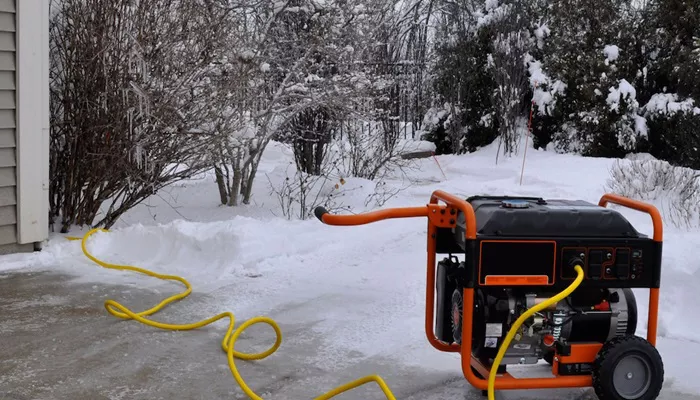Generators are essential tools for providing electricity in situations where power supply is unreliable or unavailable. A 9500-watt generator is considered a mid-range model in terms of power output. It offers sufficient capacity for both home and outdoor use. This article explores exactly what a 9500-watt generator can run, from essential household appliances to more power-hungry equipment.
How Does Generator Wattage Work?
To understand what a 9500-watt generator can run, it’s essential to first understand how wattage affects its capabilities. Wattage indicates how much electrical power a generator can produce. The wattage listed on a generator (like 9500 watts) reflects the total power it can supply to connected devices or appliances.
There are two types of wattage to consider:
Running Wattage: This is the continuous wattage a generator can handle while running.
Surge Wattage: Also known as peak wattage, this is the maximum wattage a generator can supply for short periods, such as when starting large appliances like refrigerators or air conditioners.
In the case of a 9500-watt generator, it will have a certain amount of running wattage and surge wattage. This means it can power appliances that have lower running wattages continuously and devices that need more wattage to start.
What Appliances Can a 9500-Watt Generator Run?
A 9500-watt generator is versatile and can run a wide range of appliances in various settings. Whether you’re preparing for a power outage, camping, or using it on a job site, knowing what it can power helps in efficient planning.
Essential Household Appliances
A 9500-watt generator can keep most standard household appliances running during a power outage.
Here are some examples:
Refrigerator/Freezer: These appliances typically require 600 to 800 watts to run. However, they need higher surge wattage (around 2000 watts) when starting.
Air Conditioning: A small to medium air conditioning unit requires 2000 to 4000 watts to run continuously. A 9500-watt generator can handle the load, especially when it’s not powering many other devices.
Microwave Oven: Microwaves use around 1000 to 1500 watts. A 9500-watt generator can easily power a microwave, which makes it ideal for cooking during emergencies.
High-Power Appliances
Some appliances require a higher wattage, especially during startup.
A 9500-watt generator can handle the load of these high-power devices:
Washing Machine: Standard washing machines require around 1000 to 1500 watts, but surge wattage may spike to around 3000 watts during the initial phase of operation. A 9500-watt generator can manage this load effectively.
Electric Water Heater: Water heaters usually require 3000 to 4500 watts. A 9500-watt generator can run an electric water heater, but it may be best to use the heater alone to avoid overloading the generator.
Well Pump: Depending on the size and horsepower of the pump, well pumps typically consume 1500 to 3000 watts. The surge wattage may be higher when the motor starts. A 9500-watt generator should suffice for most well pumps, though it is always important to check the specifications of the individual pump.
Power Tools and Outdoor Equipment
A 9500-watt generator is a popular choice for powering outdoor equipment, such as tools and machinery.
Here are some examples:
Electric Chainsaw: Chainsaws usually require 1200 to 2000 watts. A 9500-watt generator can easily run an electric chainsaw, allowing you to use it for extended periods.
Air Compressors: Smaller air compressors (around 1.5 HP) need 1200 to 1500 watts to run. Larger units may require more wattage, but many standard air compressors will work fine with a 9500-watt generator.
Power Saws: Whether you’re using a circular saw or a table saw, these tools typically require 1200 to 2000 watts to operate. A 9500-watt generator can easily power most power saws.
Cement Mixer: Cement mixers typically consume between 1500 to 2000 watts. A 9500-watt generator can power most small to medium-sized cement mixers without issue.
How to Calculate Wattage Requirements
To optimize the use of your 9500-watt generator, it’s crucial to understand how to calculate the wattage needed for each appliance you intend to power.
Here’s how to do it:
Check the Wattage Rating: Each appliance will have a label or manual that lists its running wattage and surge wattage.
Add Running Wattage: For each appliance you want to use simultaneously, add its running wattage together.
Consider Surge Wattage: Add the surge wattage for appliances with high startup power demands, like refrigerators or air conditioners.
Stay Within Capacity: Make sure that the total running wattage, plus any surge wattage, does not exceed the generator’s running wattage or surge wattage. A 9500-watt generator is ideal for moderate power needs but has limits.
How to Maximize Generator Efficiency
Running multiple devices on a 9500-watt generator can be tricky, but with careful planning, you can maximize its efficiency.
Here are some tips:
Prioritize Essential Appliances: Focus on running only the most essential appliances, such as refrigerators, lights, and medical equipment.
Turn Off Unnecessary Devices: Before turning on a high-power appliance, make sure to turn off unnecessary devices.
Use a Power Management System: Consider using a power management system to avoid overloading your generator and ensure you don’t exceed its limits.
Regular Maintenance: Regularly maintain your generator to ensure it operates at peak performance, including changing the oil and keeping the air filter clean.
Conclusion
A 9500-watt generator is an incredibly versatile tool that can run many household appliances, outdoor equipment, and more. It is a powerful and reliable option for both emergency situations and outdoor projects. Understanding the wattage needs of your devices and how to manage the generator’s capacity will help you make the most of its capabilities. Always remember to follow safety guidelines and regularly maintain your generator for optimal performance.

